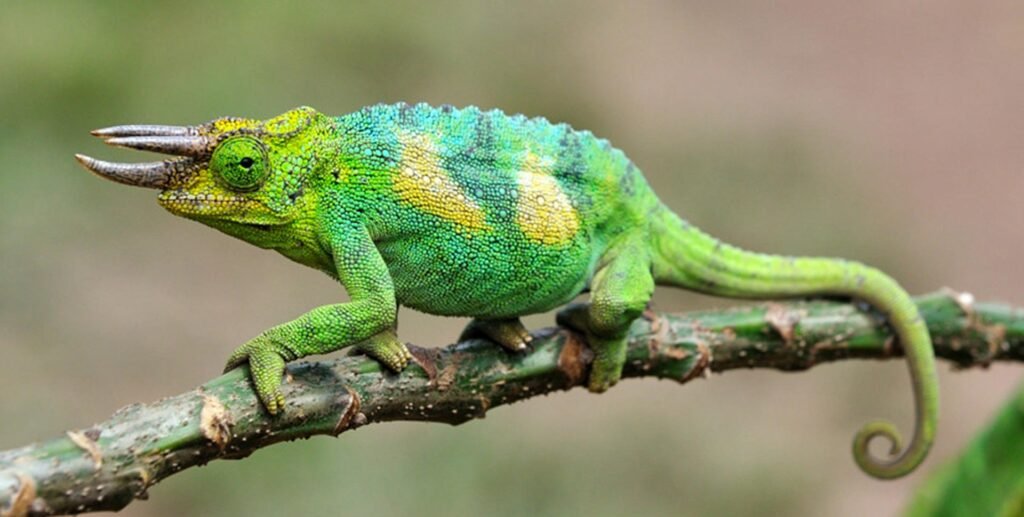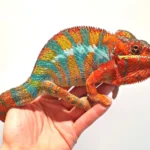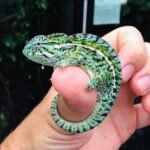Jackson’s Chameleons: The Three-Horned Wonders of East Africa
Meta Description: Discover the fascinating world of Jackson’s Chameleons. Learn about their unique three-horned appearance, care requirements, and why they’re a favorite among reptile enthusiasts. Comprehensive guide with expert tips for both novice and experienced keepers.
Jackson’s chameleon, Trioceros jacksonii, three-horned chameleon, live-bearing chameleon, arboreal reptile, exotic pet, chameleon care, UVB lighting, insectivore pet, reptile husbandry
Jackson’s Chameleons: The Three-Horned Wonders of East Africa
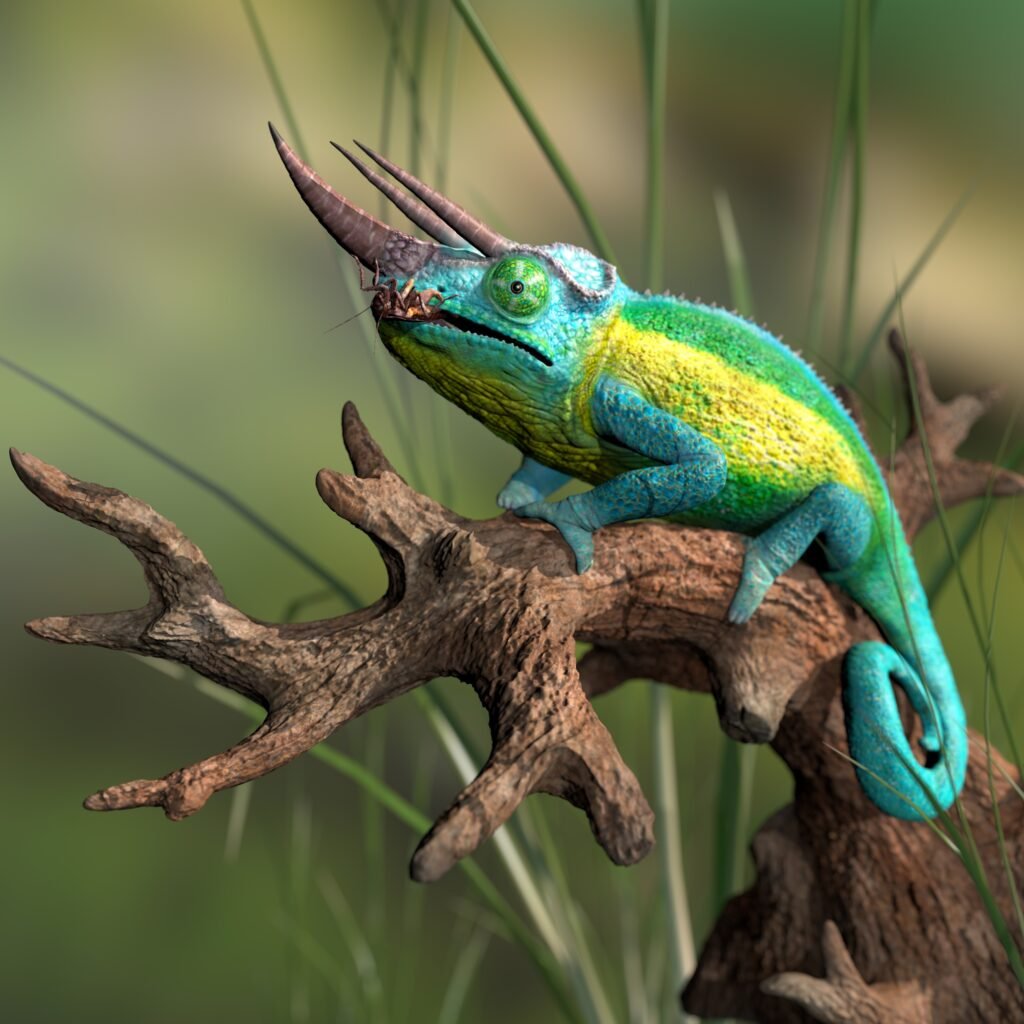
Introduction to Jackson’s Chameleons
Jackson’s Chameleons (Trioceros jacksonii) are unique among chameleons due to their distinctive three-horned appearance in males. Native to East Africa, these chameleons have captured the imagination of reptile enthusiasts worldwide. In this comprehensive guide, we’ll explore everything you need to know about these fascinating creatures.
Natural History and Origin
Jackson’s Chameleons are native to the humid, cool forests of East Africa, primarily Kenya and Tanzania. They were introduced to Hawaii in the 1970s, where they have established wild populations. Named after Frederick John Jackson, an English explorer and ornithologist, these chameleons were first described scientifically in 1896.
One of their most unique characteristics is that they are ovoviviparous, meaning females give birth to live young rather than laying eggs, which is unusual among chameleons.
Physical Characteristics
Jackson’s Chameleons possess several distinctive features:
- Size: Adults typically reach 8-13 inches (20-33 cm) in total length.
- Weight: Adults generally weigh between 2-4 ounces (55-115 grams).
- Horns: Males have three horns – two over the eyes and one on the snout. Females typically lack horns.
- Color: Base color is usually bright green, but can change to display various patterns and colors.
- Eyes: Independently moving eyes with fused eyelids.
- Feet: Zygodactylous feet adapted for gripping branches.
- Tail: Prehensile tail used for balance and climbing.
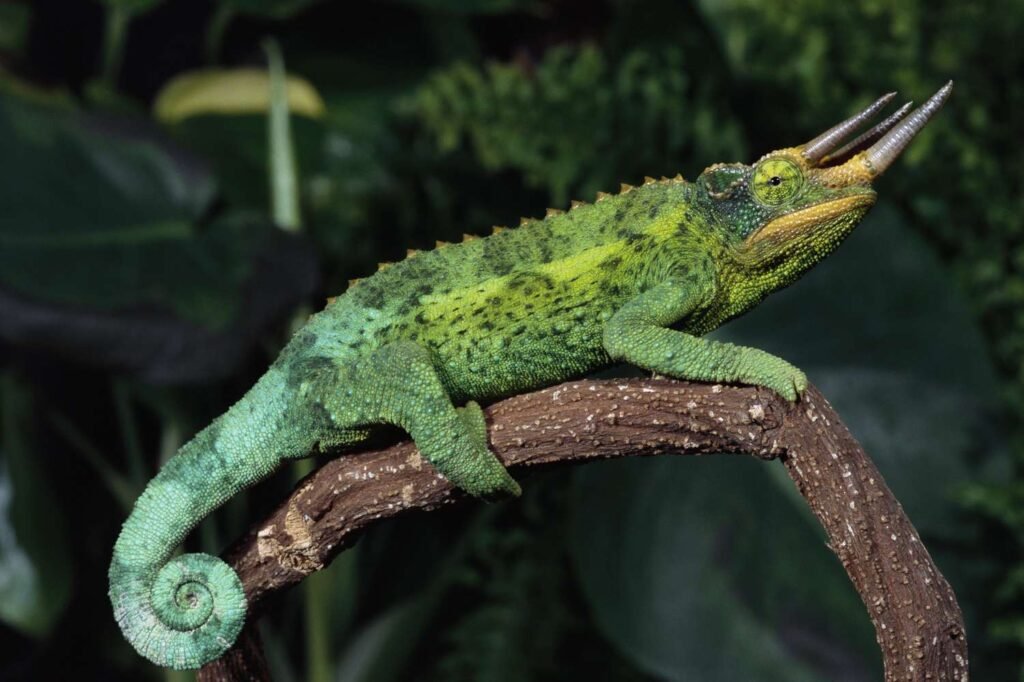
Jackson’s Chameleon Care: Creating the Ideal Habitat
Providing a suitable enclosure is crucial for the health and well-being of your Jackson’s Chameleon:
- Enclosure Size:
- Minimum size for adults: 2′ x 2′ x 3′ tall (60 x 60 x 90 cm)
- Larger enclosures are always better
- Enclosure Type:
- Screen or mesh cages for proper ventilation
- Glass terrariums are not recommended due to poor air circulation
- Temperature Gradient:
- Basking spot: 80-85°F (27-29°C)
- Ambient temperature: 70-80°F (21-27°C)
- Night-time temperature: Can drop to 60-65°F (16-18°C)
- UVB Lighting:
- Essential for vitamin D3 synthesis and calcium metabolism
- Provide 10-12 hours of UVB exposure daily
- Humidity:
- Maintain humidity levels between 50-70%
- Mist the enclosure 2-3 times daily or use an automatic misting system
- Plants and Decor:
- Include live or artificial plants for climbing and hiding
- Add branches of various diameters for perching
- Substrate:
- A substrate-free bottom is often best for hygiene
- If used, large reptile bark or coconut fiber can work
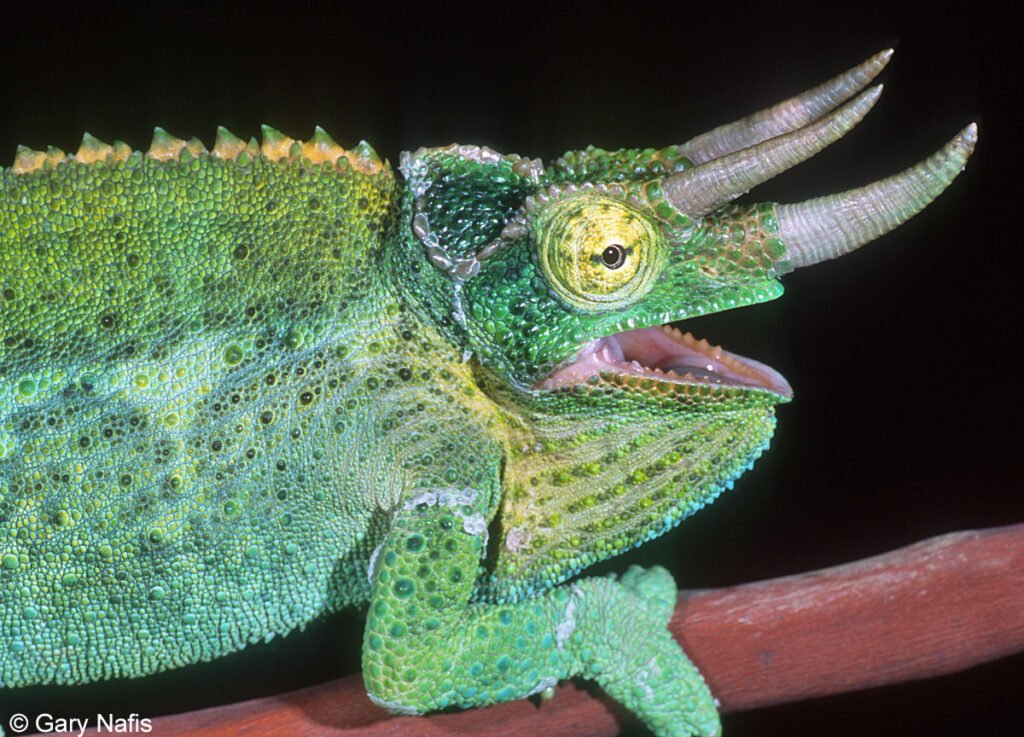
Diet and Nutrition
Jackson’s Chameleons are insectivores:
- Staple Insects:
- Crickets, dubia roaches, and silkworms
- Occasional Treats:
- Waxworms, hornworms, and flies
- Feeding Schedule:
- Adults: Feed 8-12 insects every other day
- Juveniles: Feed 5-8 small insects daily
- Supplementation:
- Dust insects with calcium powder 3-4 times a week
- Use a multivitamin supplement once a week
- Hydration:
- Mist the enclosure to provide water droplets for drinking
- Some chameleons may drink from a dripper system
Common Health Issues
While Jackson’s Chameleons can be hardy, they are prone to several health issues:
- Metabolic Bone Disease:
- Caused by calcium deficiency or improper UVB lighting
- Symptoms include soft or deformed bones, tremors, and lethargy
- Respiratory Infections:
- Often due to incorrect temperature or humidity
- Symptoms include wheezing, open-mouth breathing, and mucus around the nose
- Eye Infections:
- Can be caused by vitamin A deficiency or poor husbandry
- Symptoms include swollen eyes or eyelids
- Stress-related Issues:
- Can lead to decreased appetite and lowered immune function
- Provide adequate hiding spots and minimize handling
- Parasites:
- Both internal and external parasites can affect chameleons
- Regular fecal exams by a veterinarian are recommended
Regular check-ups with a reptile veterinarian experienced in chameleon care are essential for maintaining your pet’s health.
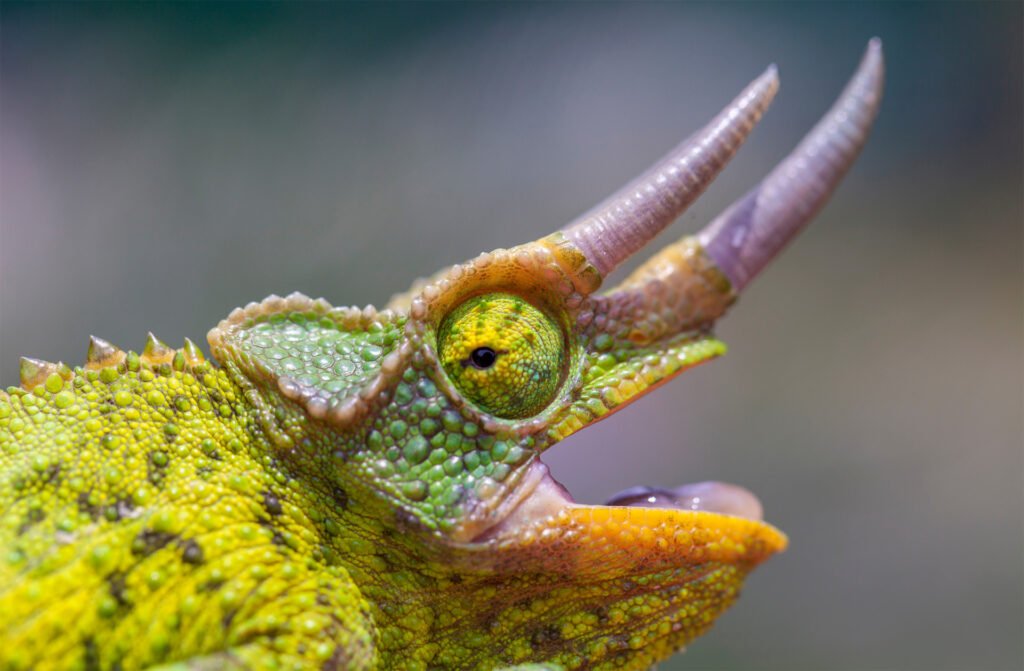
Behavior and Handling
Understanding Jackson’s Chameleon behavior is key to successful ownership:
- Color Changes: Used for communication, thermoregulation, and camouflage.
- Territorial Behavior: Males are particularly territorial and should not be housed together.
- Stress Signals: Darkening of color, hiding, or gaping mouth can indicate stress.
- Handling: Generally tolerate gentle handling but prefer to be left alone.
- Activity: Most active during the day, basking and hunting.
FAQs About Jackson’s Chameleons
Q: How long do Jackson’s Chameleons live?
A: With proper care, they can live 5-10 years in captivity.
Q: Can Jackson’s Chameleons be housed together?
A: It’s generally not recommended. They are solitary animals and can become stressed or aggressive if housed together.
Q: How often do Jackson’s Chameleons shed?
A: They shed their skin regularly, often eating the shed skin for its nutritional value.
Q: Are Jackson’s Chameleons good pets for beginners?
A: Due to their specific care requirements, they are better suited for keepers with some reptile experience.
Q: How many babies do Jackson’s Chameleons have?
A: Females typically give birth to 8-30 live young per litter, usually twice a year.

Estimated Prices for Jackson’s Chameleons in Different Countries
Please note that these are rough estimates and prices can vary based on availability and source.
| Country | Estimated Price Range (in local currency) | Approximate USD Equivalent |
|---|---|---|
| United States | $100 – $300 | $100 – $300 |
| United Kingdom | £80 – £250 | $110 – $345 |
| Canada | CAD 130 – CAD 400 | $100 – $310 |
| Germany | €90 – €270 | $105 – $320 |
| Australia | AUD 150 – AUD 450 | $105 – $315 |
| Japan | ¥12,000 – ¥36,000 | $110 – $330 |
Quick Facts About Jackson’s Chameleons
| Characteristic | Information |
|---|---|
| Scientific Name | Trioceros jacksonii |
| Average Size | 8-13 inches (20-33 cm) |
| Lifespan | 5-10 years in captivity |
| Native Habitat | East Africa (Kenya, Tanzania) |
| Diet | Insectivore |
| Temperature Range | Basking: 80-85°F, Ambient: 70-80°F |
| Humidity Range | 50-70% |
| Activity Pattern | Diurnal |
| Temperament | Generally calm, but prefer minimal handling |
| Social Structure | Solitary |
| Unique Features | Three horns in males, live-bearing |
| Conservation Status | Least Concern (IUCN), but habitat threatened |
In conclusion, Jackson’s Chameleons are fascinating reptiles that offer a unique pet-keeping experience. Their distinctive three-horned appearance and live-bearing reproduction make them stand out among chameleon species. While they require specific care and are best suited for keepers with some experience, they can be rewarding pets for those willing to meet their needs. By providing proper housing, nutrition, and care, you can ensure that your Jackson’s Chameleon thrives in captivity. Remember to continue researching and consulting with experienced keepers or exotic veterinarians to provide the best possible care for your three-horned companion. Embrace the adventure of Jackson’s Chameleon ownership, and you’ll discover a world of reptilian wonder that’s as unique and captivating as your pet’s distinctive appearance!
